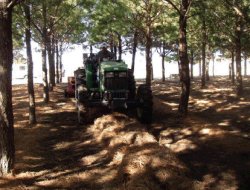AgEBB-MU CAFNR Extension
Green Horizons
Volume 20, Number 1
January 2016
Mulching (if done right) Benefits Trees and Shrubs!By Jerry Van Sambeek, Northern Research Station
Mulch, as it naturally occurs in forests, has been described as a nutrient rich, moisture absorbent bed of decaying forest leaves, twigs, and branches, teeming with fungal, microbial, and insect life. Trees and shrubs grow faster when mulched with organic mulches such as pine needles, shredded leaves, chipped landscape waste, bark, and grass clippings than when the area under the canopy is kept free of vegetation through tillage or herbicides. Studies have shown that growth of walnut and other fine hardwoods is increased on average 26 to 29 percent over that for hardwoods with bare ground beneath them. Increased tree growth can be nearly double that of trees growing in grasses or weedy vegetation (89% for walnut and 78% for other fine hardwoods).
 |
Mulches do many other marvelous things when applied under trees and shrubs. Reports suggest that the physical effects of organic mulches are much greater than the fertilizer value associated with release of nutrients as mulches decompose. Decomposition increases soil organic matter leading to better soil health, retention of water and nutrients, and increased soil activity by earthworms, fungi, and other soil organisms. Mulches reduce both loss of soil moisture and the impact of raindrops, slow the flow of water over the soil, and increase rates of water infiltration. Mulches also moderate the soil microenvironment damping temperature fluctuations at the soil surface in addition to keeping soil temperatures lower in summer and warmer in winter than under bare ground or turf. Reducing soil temperature extremes can be important as death of tree roots commonly occurs at temperatures greater than 90O F and less than 20O F. Perhaps the best thing about mulching is that it keeps mowers, string trimmers, and other equipment away from tree trunks.
Shawn Fitzgerald, ISA-certified arborist and technical advisor at Davey Tree, provided the following five easy mulching tips in a recent blog that I have taken the liberty to expand upon.
- Choose the right mulch. To save water in the yard and garden, use organic mulch because it breaks down and conditions the soil. Mulching is one of the most effective ways to conserve water to support tree growth—and it's also the easiest. Pine needles (sold as "pine straw") give a good bang for your buck because they retain the most moisture and suppress weeds better than any other mulch. In addition, they don't need to be replenished as often, are attractive on the landscape, create a favorable nutrient balance and are least likely to alter soil pH. Other forest fiber with a good balance of carbon to nitrogen, such as shredded leaves and hardwood bark, also work well. Fine textured mulches such as grass clippings should be mixed with other mulches to keep them from packing and slowing water infiltration. Mulches high in carbon such as paper, sawdust, and wood shavings should be mixed with grass clippings or nitrogen fertilizers. Nonorganic mulches, such as gravel, stone, and manufactured products — including plastic films and landscape fabrics—can block water and air movement.
- Ready the space. Before mulching, remove weeds from garden beds and around trees and shrubs to eliminate hours of weeding later in the season.
- Apply mulch. For most plants and garden beds, apply 2-3 inches of mulch-not so deep as to inhibit soil aeration but still thick enough to block sunlight and minimize emergence of germinating weed seeds. If you have sandy soil, apply an additional inch of mulch. If you're mulching shallow-rooted plants, such as hydrangeas, boxwoods, or azaleas, apply a bit less.
- Use mulch to mimic the "wild" or the natural condition found in forests. Fitzgerald says cover the plant's entire drip zone, which is as far as the leaves grow out from the trunk or stem to "mimic the wild". Doing so mirrors the forest condition and allows plants to thrive. When mulching trees, the larger the mulch ring, the greater the benefit to the tree. However, when it comes to tree growth, recent research suggests that maintaining the area along one side of a tree free of grass competition using herbicides or mulch may be as effective as maintaining the entire area under the tree canopy grass free. For newly planted hardwood seedlings, mulching a circle 4' in diameter (12 ft2) or 4' square (16 ft2) is recommended.
- Avoid "volcano" mulching. Volcano mulching is piling mulch deeper around a tree trunk or plant stem than near the dripline which minimizes air movement into the soil and prevents deep roots from growing. Fitzgerald warns, "Volcano mulching" is one of the worst things you can do to a plant or tree." Mulch should be pulled at least 2-to-6 inches away from the tree trunk, stem, or flare so it remains dry and less vulnerable to infection by root and stem diseases. Mulches should also be pulled away from the tree trunk to minimize cover for mice and voles especially in the winter when they do the most damage.
 |
Watch a related short video on Effective Mulching at the Davey Web site (http://www.davey.com/arborist-advice/video/landscape-tips-effective-mulching/).
